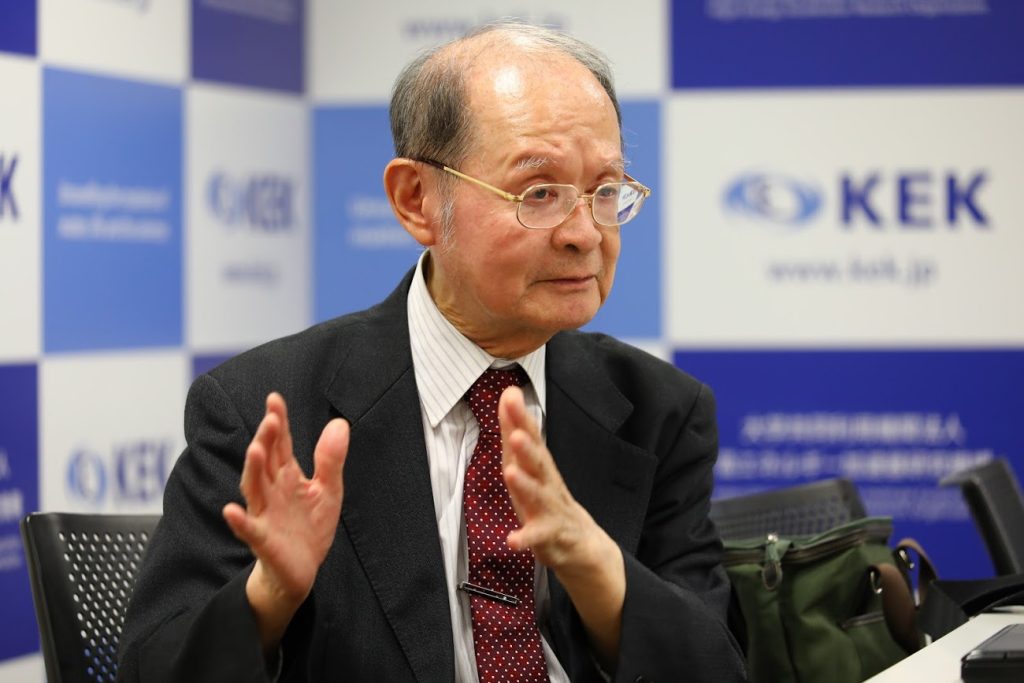
KEK名誉教授の永嶺謙忠さんがこのほど、優れた業績を上げた研究者に贈られる日本学士院賞を受賞しました。火山など巨大な物体の内部構造を探る手法を開発するなど、ミュオンによる学際的科学を発展させた業績が評価されました。ミュオン一筋の研究者生活を現在も続ける永嶺さんに、ミュオン研究の面白さなどを聞きました。
まず、ミュオンとは何ですか
ミュオンは私が生まれる少し前の1937年に宇宙線の中に見つかった素粒子で、プラスとマイナスの電荷のものがあります。質量は電子の207倍で寿命は2.2マイクロ秒です。安定な陽子と電子、ニュートリノを除いて中性子の次に寿命が長い粒子がミュオンです。ミュオンは構造がない素粒子で、周囲の原子分子との相互作用は電磁気的な相互作用が主体です。ミュオンをさまざまなエネルギーにすることで各種の物質を通過させることができ、火山、溶鉱炉、建造物、人体・脳、さらにナノ材料の中まで覗くことができます。
いつミュオンに着目されたのですか
高校生の頃は数学をやりたいと思っていましたが、自然を理解するには物理学が一番だと思って東京大学の工学部応用物理学科に進みました。大学院では理学部物理学科で核物性を専攻しました。博士課程の3年のころ、東大の工学部物理工学の助手となり3年後に理学部物理学科の助手に移り、そのころ山崎敏光先生と一緒に原子核の構造をミュオンで見る方法を見つけ、ミュオンが物性研究に有効だと思うようになりました。
博士課程の頃からずっとミュオン一筋ですね
そのから、山崎教授統率の下カリフォルニア大学バークレー校やカナダのブリティッシュコロンビア大学TRIUMFでミュオンの研究をしました。帰国して、東大の山崎教授の下に戻って、高エネルギー物理学研究所の中に東大の分室を作ってもらい、陽子シンクロトロンでパルス状のミュオンを作り、その崩壊現象を見ることに世界で初めて成功しました。先の直流状ミュオンのカナダのTRIUMFに対しては、後に超伝導ミュオンチャンネルを作って、それをブリティッシュコロンビア大学に寄付しました。1990年頃からは、主任研究員を兼務した理化学研究所から英国ラザフォードアップルトン研究所に超伝導ミュオンチャンネルを作り、世界最強のパルス状ミュオン施設を作り、2010年以降のJ-PARCに引き継いでいます。
ミュオンによる火山のレントゲン撮影に成功して、世界中をびっくりさせました
宇宙線ミュオンを使って巨大物質の中を見る試みは、1970年に米国のアルヴァレという物理学者が、エジプトのピラミッドの中に隠された墓室を探すため、ピラミッドの中の地下トンネルの真ん中にカウンターをおき、上から降ってくる宇宙線ミュオンを使った実験が有名です。私どもはそれに対して、水平すれすれに横から来る宇宙線ミュオンで火山のレントゲン写真を撮ることに挑戦して、トンネルを掘らずに巨大物体の内部を探る実験手法を完成させました。

それはどういうきっかけで
1991年に雲仙普賢岳が噴火しました。私はカナダに向かう飛行機の中で日本の新聞を広げた時、天皇陛下が噴火による被災者を見舞われている記事を見つけ、私にも何かできることはないかと思いました。そして、アメリカの物理学者がピラミッドの内部を宇宙線で調べたことを思い出して、普賢岳の真下にトンネルを掘って、そこにディテクターを設置することを考えたのです。しかし、山の真下にトンネルを掘るというのはどうにも無理なので、その代わりに縦横の二方向に分割した複数の位置敏感プラスチックカウンターを火山の裾野に置く方法を考案しました。 これを筑波山で実験して、筑波山の内部の断層撮影に成功しました。続いて、火山の浅間山で実験しました。ちょうど2004年噴火の前に私どもが、後に東大地震研グループが測定できたので、噴火前後で火口部の形状が変化していることを世界で初めて証明しました。その後、溶鉱炉や原子炉でも実施しました。
最近、ミュオンで富士山を調べることを始めたのは、いつ噴火してもおかしくないと言われているからです。普通の山は頂上近くから川が流れ出すのですが、富士山には上方に川がありません。だから、内部に大きな水がめになっている空洞があるに違いないと思います。ということは噴火前に水蒸気爆発を起こします。富士山の周辺に多数のプラスチックシンチレーションカウンターを並べれば、マグマの動きを直接見ることができ、噴火の予知もできると思います。
溶鉱炉や原子炉でもミュオンラジオグラフィに挑戦しました
2004年、大分県の世界最大の生産量を持つ溶鉱炉を観測しました。溶鉱炉では耐火レンガが劣化してくるので20年くらいで建て替えるものです。その耐火煉瓦炉壁の劣化具合を宇宙線ミュオンで調べるのです。炉壁がどれぐらい減っているか溶鉱炉を運転させながら測れることを示せました。
宇宙線ミュオンだけでは測定対象に限界がありますね
加速器でミュオンを作ると、エネルギーは低いけれど強度は宇宙線の1億倍ぐらいになるので、もっとデリケートなことがやれます。ミュオンを物質に止めて、そこから反射的に発生する陽電子の強度の時間変化を見ることで、ミュオンの止まった場所の原子レベルの磁場の様子を知ることができます。この観測法をμSR法と言います。これで、大型建造物、特に鉄筋コンクリートの腐食具合を外から調べることができます。コンクリートにミュオンが止まると、ミュオンスピンはじっとしたままです。ところが鉄に止まると、鉄の磁性を感じてクルクル回り始めます。腐食の度合に応じて鉄の磁性が変わり、ミュオンスピンの回転の様子が変わります。こうして鉄棒の腐食具合を見ることができます。無理をすれば宇宙線ミュオンで出来ることを示しましたが、簡易型加速器でミュオンを作って使うことが考えられます。
最初に人体や脳も透視できるとおっしゃいましたが
ミュオンビームのエネルギーと方向をコントロールしながら、mmの精度で脳の中にミュオンを止めてμSR法を適用できると考えています。既に血液の酸化程度が測れることが解っています。いつしか素粒子が人間の脳のこれまで分かっていなかった機能を見ることができる時代が来ると思います。
改めて日本学士院賞の受賞おめでとうございます。今日はありがとうございました。
(聞き手 広報室)
